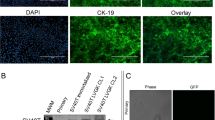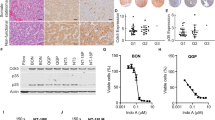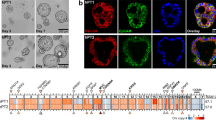Abstract
Primary human panceratic exocrine adenocarcinoma has been established in tissue culture and as xenografts in immune-deficient nu/nu mice. The cell line has a doubling time of 36 h and grows as a confluent monolayer together with a constant population of free-floating cells. Evidence of tumourigenicity was provided by growth on an early diploid fibroblast monolayer and in soft agar, and as solid tumours in immune-deficient nu/mu mice. Chromosome analysis of the cultured cells confirmed their tumour origin. Xenografts established from the cell line or directly from primary tumour tissue have retained a similar histology to the original tumour on serial transplantation. An electrophoretic study of exportable pancreatic digestive enzymes and a number of intracellular enzymes has shown that the cell line and xenografts maintain a human intracellular enzyme profile, but do not produce pancreatic digestive enzymes.
This is a preview of subscription content, access via your institution
Access options
Subscribe to this journal
Receive 24 print issues and online access
$259.00 per year
only $10.79 per issue
Buy this article
- Purchase on Springer Link
- Instant access to full article PDF
Prices may be subject to local taxes which are calculated during checkout
Similar content being viewed by others
Rights and permissions
About this article
Cite this article
Grant, A., Duke, D. & Hermon-Taylor, J. Establishment and characterization of primary human pancreatic carcinoma in continuous cell culture and in nude mice. Br J Cancer 39, 143–151 (1979). https://doi.org/10.1038/bjc.1979.24
Issue Date:
DOI: https://doi.org/10.1038/bjc.1979.24
This article is cited by
-
Establishment of a human pancreatic adenocarcinoma cell line (JF305) with p53 expression
Chinese Journal of Cancer Research (1995)
-
Characterization of three cloned cell lines from aN-nitrosobis(2-hydroxypropyl)amine-induced transplantable hamster pancreatic ductal adenocarcinoma
International journal of pancreatology (1994)
-
Structural analysis of a new highly metastatic cell line PaTu 8902 from a primary human pancreatic adenocarcinoma
Virchows Archiv B Cell Pathology Including Molecular Pathology (1993)
-
A new human pancreatic carcinoma cell line developed for adoptive immunotherapy studies with lymphokine-activated killer cells in nude mice
In Vitro Cellular & Developmental Biology (1988)
-
Considerations in the use of nude mice for cancer research
Cancer and Metastasis Review (1984)



